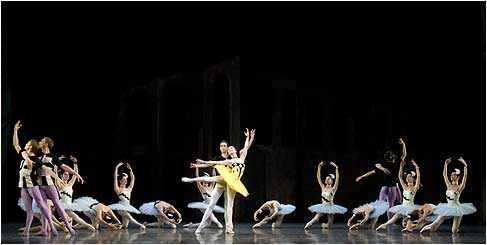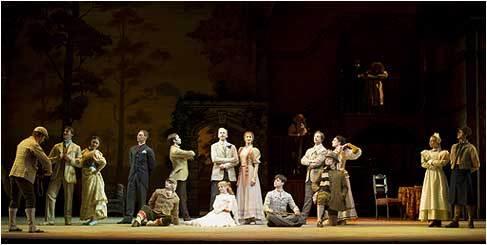FREDERICK ASHTON BIOGRAPHY by Julie Kavanagh
It's easy to forget that Frederick Ashton, founding genius of English ballet, was originally South American. The youngest of four boys, he was born in Guayaquil, Ecuador on 17 September l904, and brought up in Lima, Peru where his sister was born. Ashton's father, a businessman and vice-consul, was British, and so was his mother, who introduced her impressionable son to the airs and graces of belle epoque Lima. Images from childhood - the languorous sensuality of tango dancers at colonial tea dances, the swaying, ritualized walk of feast day processions - stayed with Ashton, infiltrating his choreography. His Roman Catholic schooling also found expression in his ballets. The ceremony and mystical potency of high mass influenced his timing of effects and climaxes, while the ecstatic, baroque indulgence of Spanish religion is obliquely sublimated in Symphonic Variations, his greatest and most life-affirming work. More crucially, it was an epiphanic experience in Lima that decided the 13 year old Ashton's destiny. This was a performance by Anna Pavlova that not only triggered his vocation to dance, but is the palimpsest behind every ballerina role he went on to create.

Sylvia
© ROH/ Tristram Kenton
He was a late starter. After three years in an English boarding school, and a spell of working as a clerk in the City, Ashton began taking weekly private lessons with Leonid Massine, and went on to become a pupil of Marie Rambert. Although he lacked strength and technique, he had a natural elegance and lyricism that enabled him to make his debut as a danseur noble, partnering the great Tamara Karsavina in Les Sylphides. Rambert, divining where Ashton's true gift lay, gave him the opportunity to choreograph his first ballet in l926, designed by Sophie Fedorovich, a close friend and formative collaborator. A Tragedy of Fashion, while youthfully over-indebted to the chic milieu of Bronislava Nijinska's Les Biches, immediately showed a remarkable ability to transpose character into movement. In l928 when Ashton joined the Ida Rubinstein company in Paris, he was able to perfect his craft by apprenticing himself to Nijinska, who taught him how to personalize the language of classical ballet and make it relevant to his time.
Another crucial early influence was Diaghilev's baby ballerina Alicia Markova. Knowing that her career had been put in jeopardy by the impresario's recent death, Ashton arranged for her to be taken on by Rambert as a guest artist - the start of a remarkable collaboration. If Ashton rescued Markova and was responsible for creating a personal repertory that displayed her virtuosic technique and sophisticated musicality, she, with her link to the deities of ballet from Spessivtzeva to Stravinsky, provided him with the experience and heritage that he lacked.

Scènes de ballet
© ROH/ Johan Persson
During the l930s, as both a dancer and choreographer, Ashton shared himself between Rambert's small troupe as well as that of Ninette de Valois, while supplementing his meager income by working in commercial theatre. In l935, having established a professional company of her own, de Valois invited Ashton to join her at the Vic-Wells Theatre where, under the inspired musical guidance of Constant Lambert, a native ballet began to evolve. What we have come to call "the English style" was embodied by Ashton's muse, Margot Fonteyn, whose own restraint, simplicity and poise was enriched by traces of the lush, romantic plastique he had loved in Anna Pavlova. After the war, de Valois' company - renamed The Royal Ballet - moved to the Royal Opera House, and in l963, when she retired, Ashton took over as director, remaining in the post for the next seven years.
With an oeuvre of over one hundred works - at least four of which, Symphonic Variations, Scènes de Ballet, The Dream and la Fille mal gardée, are 20th century masterpieces - Frederick Ashton is unquestionably one of the most important choreographers in the history of ballet. He was also a major figure in the cultural landscape of the day: Gertrude Stein pronounced him a genius; Yeats wanted him to direct plays at The Abbey Theatre; Matisse was inspired by the spontaneous flow of his movements; the three Sitwell siblings all sought his company. He took delight in cultivating a dazzling life outside his profession, drawn into the Bright Young set of the Twenties, and launched into English society in the l930s, by the American millionairess Alice Astor. Success in this world was Ashton's fieldwork. The aristocratic manners and mores he observed, like his ability to capture the very essence of a person and their surroundings, imbued ballets such as A Wedding Bouquet and Enigma Variations with their vividness of character and period.

Enigma Variations
© ROH/ Bill Cooper
The content of Ashton's work is as personal as its style. He was a romantic, whose emotional life acted as an important creative impetus. Unrequited love for a beautiful young man is the inspiration behind more than one ballet, his own suffering and yearning encoded most ingeniously of all in the story of Two Pigeons, a fantasy about infidelity and reconciliation. Enigma Variations, Ashton's portrayal of the composer Edward Elgar's feelings of professional neglect, is also a confession of the insecurity he himself was experiencing at the end of his career. He need not have been concerned. A recipient of the Order of Merit - the most distinguished honour of all - Sir Frederick Ashton, in his final years, was a national treasure. Not only that, he was a court favourite, a member of the Queen Mother's inner circle, accepted and beloved for his unthrusting nature, brilliant wit and incomparable impersonations. And today, although the choreographer will always live on in his ballets, it is the man himself who is greatly missed. Those who remember Ashton's curtain calls will still picture his pit-pattering along the inside of the drapes to stir-up anticipation before he appeared on stage. Then the slow, regal wave acknowledging the adoration "a la Pavlova", he used to say: first up to the gods, where the true balletomanes sat, then the balcony, grand tier and stalls. Blessed with the common touch, Ashton never lost his degree of humility that was both genuine and tongue-in-cheek. 'Is this really all for me,' he seemed to be saying, "Little Freddie Ashton from Lima, Peru?"

